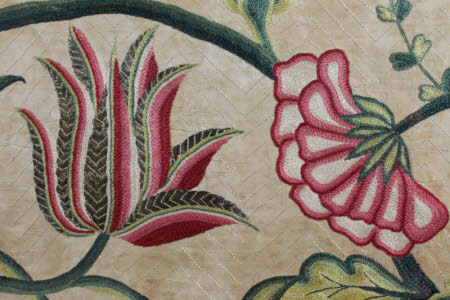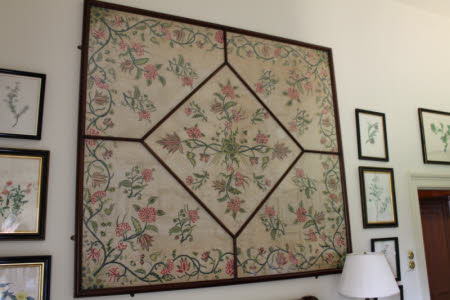Coverlet
Unknown Indian embroiderers
Category
Textiles
Date
c. 1740 - c. 1760
Materials
Cotton, Silk thread, Wood
Measurements
160 cm (h)175.25 cm (w)
Place of origin
Gujarat
Order this imageCollection
Vyne Estate, Hampshire
NT 719693
Summary
Embroidered coverlet with a central symmetrical pattern of intertwined green leafy stems and red flowers surrounded by flowering sprigs and bordered by green flowering stems with red and while flowers mounted in a decorative wooden frame. Chain stitch in silk on linen, Gujarat, India c.1740-1760
Full description
Coverlet decorated with a pattern of silk polychrome embroidered flowers and scrolling leaves on a white cotton ground decorated with chevrons, c. 1740 – 1760, mounted in an early 20th-century decorative wooden frame. The embroidery was made in the Gujarat region of India by unknown textile manufacturers. The motif of a flowering tree decorates each corner, with the branches of each creating an interconnecting border, and is repeated at the centre in a quartered design. It is embroidered in fine chain stich known as ari-work, named after the ari hook used by professional craftsmen of the Mochi community in western India. By the early eighteenth-century India had a well-established textile trade producing printed and embroidered fabric. Exported from the port of Cambay (modern Khambat) by the East India Company and known as 'Cambay embroideries', embroideries such as this were commonly used for bed hangings and coverlets as well as fashionable dress. Another, earlier example of ‘Cambay embroidery’ c. 1700-1730, imported by the East India Company, decorates the pelmet of a bed in the collections at Osterley (NT 771814).
Provenance
Bequeathed in 1956 to the National Trust with The Vyne House and Estate by Sir Charles Chute.
Makers and roles
Unknown Indian embroiderers, embroiderer


